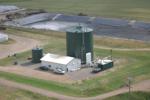Our final stop in Wisconsin was in the town of La Crosse, where, in addition to appearing on the local TV news (click here to watch the clip on Youtube!), we stayed with a Karolanne and Karen. Karolanne works with ‘Dairlyand Power Cooperative,’ a company that generates and provides electricity for about half a million people around the area. (You can see Karolanne at the end of the last video we posted here – she is the one jumping up and encouraging you to change your light bulb.)
As Bill and I are energy dorks, we enjoyed asking Karolanne all sorts of questions about how energy is produced and used in Wisconsin. (Interesting fact that we learned: the electricity use in Wisconsin for air conditioning in the summer now exceeds the electricity use for heating in the winter).
It turns out that coal, which is one of the biggest producers of carbon dioxide, is still cheaper than renewable energy, but that the state is doing many things to promote renewable energy. We also learned that a new type of electricity generation, which Karolanne dubbed ‘Cow Power’ is becoming viable in Wisconsin. We decided to let Karolanne, who is shown on the right with digested cow manure, explain in her own words.
How does Wisconsin promote renewable Energy?
Wisconsin has a renewable portfolio standard that mandates all utilities in Wisconsin to produce 10% of their energy from renewable resources by 2015. My company, DPC, also has various incentive and rebate programs that encourage members to buy energy efficient appliances. DPC produces renewable energy from wind, landfill-gas-to-energy plants, hydropower and manure digesters — manure digesters are also known as ‘cow power.’
Please explain ‘Cow Power’ to us. It sounds pretty cool.
“Cow power” plants use dairy cow manure as the energy source. The manure is collected and heated, creating the natural byproduct of methane gas. That methane is the fuel used to power the generators.
We currently have three of these power plants (one shown on the right). Each of these anaerobic manure digester facilities can generate enough to power at least 600 homes (775-840 kilowatts). Our long-term goal is to create enough power from these digesters to power approximately 20,000 homes (25 Megawatts).
What else is great about ‘Cow Power?’ (besides the name)
Manure digesters also help farmers.
* This energy source is abundant and “natural” to our region. Unlike some forms of renewable generation, this fuel is a constant, steady source. As long as there are livestock farms, there will be an available supply of manure.
* Clean air and water pollution issues associated with manure disposal are significantly reduced, as is the odor problem.
* Weed seeds and pathogens are killed during the digestion process.
* The heated, de-watered byproduct of the digestion process can be used as natural bedding. The liquid can be used as a fertilizer by the farmer, thus reducing dependence on chemical fertilizers.
* Odor issues, an increasing problem for farmers, are reduced by the manure digesters.
* Potential pollutants from manure in ground and surface water are minimized.
Learn more about Dairyland Power Cooperative and their renewable energy resources at www.dairynet.com.
Thanks! And, as we said before, be sure to see Karolanne in our video of crossing Wisconsin!










Leave a Reply